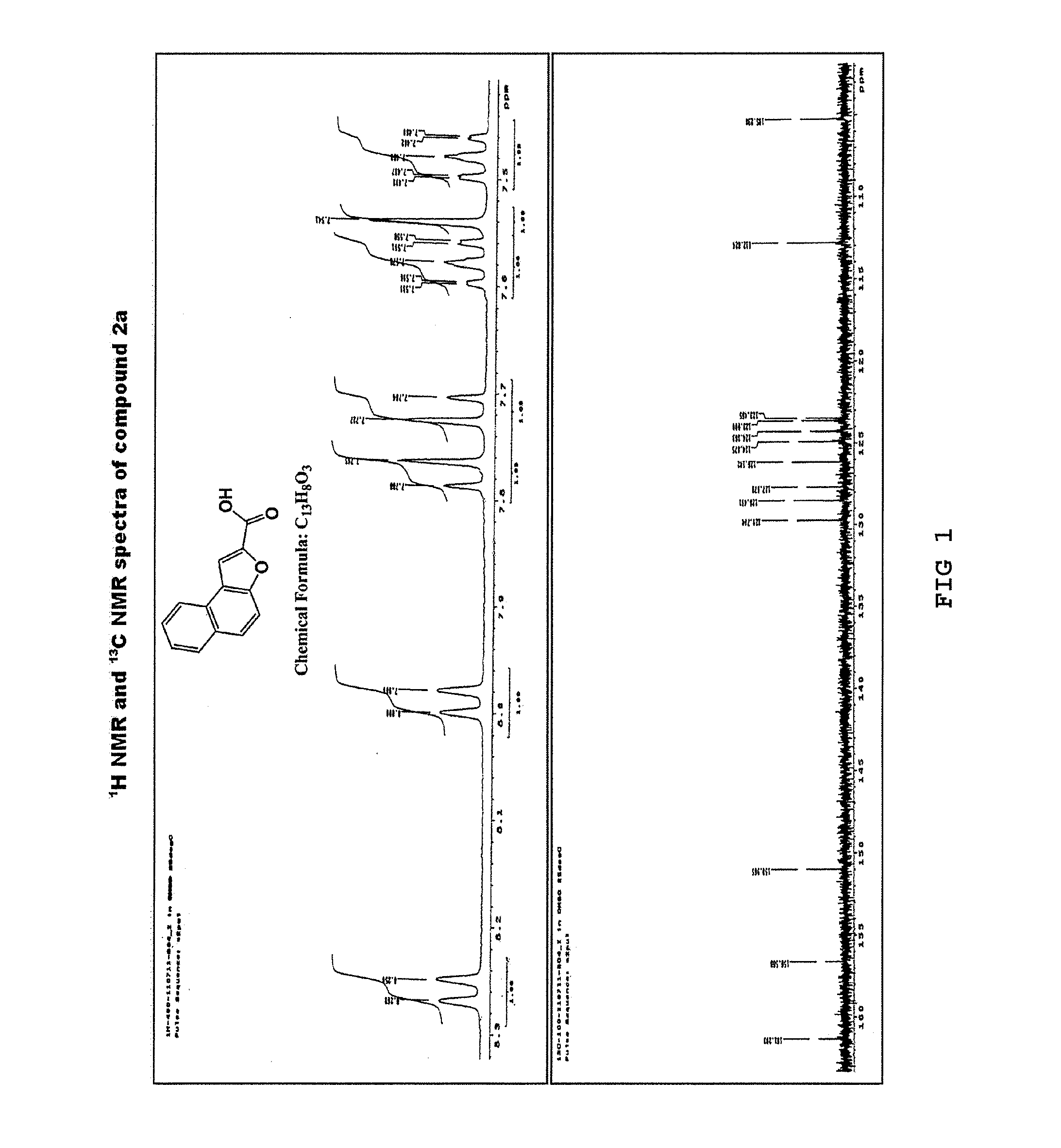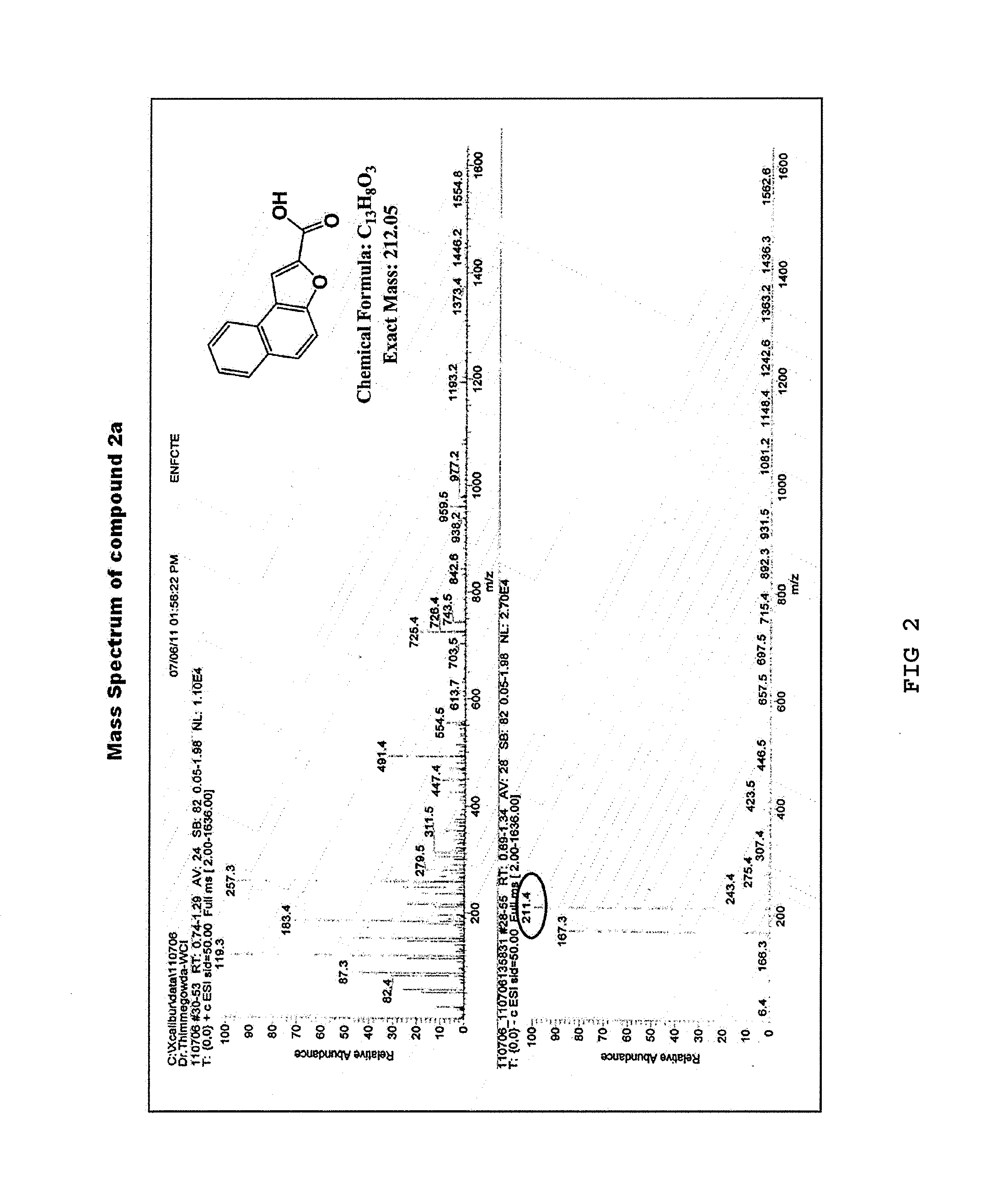Novel tubulin polymerization inhibitor and method for synthesizing same
a tubulin and polymerization inhibitor technology, applied in the field of new tubulin polymerization inhibitors, can solve the problems of affecting the quality of life of cancer patients, affecting the overall response and survival of cancer patients, and low oral bioavailability, so as to inhibit mitosis, inhibit microtubule polymerization, and induce apoptosis
- Summary
- Abstract
- Description
- Claims
- Application Information
AI Technical Summary
Benefits of technology
Problems solved by technology
Method used
Image
Examples
example 1
Synthesis of naphtho[2,1-b]furan-2-carboxylic acid (2a)
[0060]
[0061]Under a nitrogen atmosphere, anhydrous potassium carbonate (K2CO3) (64.13 g, 290 mmol) was added to a solution of 2-hydroxy-1-naphthaldehyde (1) (10 g, 58 mmol) in anhydrous dimethylformamide (DMF) (150 mL). The mixture was stirred at room temperature for 30 minutes, to which ethyl bromoacetate (8.36 mL, 75 mmol) was added. Then, the resulting reaction mixture was heated at 140° C., stirred for 22 hours, and cooled at room temperature, and the reaction mixture was poured to ice cold water. The resulting solid was filtered, washed with water, and dried. Then, the product was recrystallized from diethyl ether to yield a purified product of naphtho[2,1-b]furan-2-carboxylic acid (2a) as a pale brown solid (11.3 g, yield 92%) (Rf=0.14) and ethyl naphtho[2,1-b]furan-2-carboxylic acid (2b) as a yellow solid (0.7 g, yield 5%) (Rf=0.87) (hexane:ethyl acetate=1:1).
[0062]The 1H NMR and 13C NMR spectra of the resulting naphtho[2...
example 2
Synthesis of ester ethyl naphtho[2,1-b]furan-2-carboxylic acid (2b)
[0064]
[0065]Naphtho[2,1-b]furan-2-carboxylic acid (2a) (10.0 g, 47 mmol) obtained in Example 1 was dissolved in dichloromethane (CH2Cl2) (100 mL) and anhydrous ethanol (EtOH) (150 mL) in an oven-dried round-bottom flask under a nitrogen atmosphere. The solution was cooled to 0° C. in an ice bath, to which thionyl chloride (SOCl2) (5.1 mL, 70.5 mmol) was slowly added as droplet form via a syringe. The resulting reaction mixture was stirred at 0° C. for 30 minutes and 50° C. for 6 hours, the solvent was removed, and then the residue was diluted with H2O and ethyl acetate. After phase separation, the aqueous layer was extracted with ethyl acetate (3×250 mL), and the organic layer was dried over anhydrous Na2SO4, filtered, and concentrated under vacuum. The concentrate was recrystallized from diethyl ether and hexane to yield a purified product of ethyl naphtho[2,1-b]furan-2-carboxylic acid (2b) as a yellow solid (6.8 g,...
example 3
Synthesis of naphtho[2,1-b]furan-2-carbohydrazide (3)
[0068]
[0069]5 mL of hydrazine hydrate (NH2NH2H2O) was added to an ethanol solution (EtOH) (100 mL) of ethyl naphtho[2,1-b]furan-2-carboxylic acid (2b) (5 g, 20.8 mmol) obtained in Example 2. The reaction mixture was heated at 70° C., stirred for 4 hours, and cooled at room temperature, and the reaction mixture was poured to ice cold water. The resulting solid was filtered, washed with water, and dried. Then, the product was recrystallized from diethyl ether and hexane to yield a purified product of naphtho[2,1-b]furan-2-carbohydrazide (3) as a pale yellow sold (3.4 g, yield 72%).
[0070]The 1H NMR spectrum of the resulting naphtho[2,1-b]furan-2-carbohydrazide (3) is shown in FIG. 5, and the mass spectrum is shown in FIG. 6.
[0071]1H NMR (400 MHz, DMSO-d6) δ ppm: 10.049 (1H, s, θ═C—NH—), 8.340-8.320 (1H, d, J=8.0, Ar—H), 8.175 (1H, s, Ar—H), 8.080-8.060 (1H, d, J=8.0, Ar—H), 7.978-7.954 (1H, d, J=9.6, Ar—H), 7.816-7.794 (1H, d, J=8.8,...
PUM
| Property | Measurement | Unit |
|---|---|---|
| temperature | aaaaa | aaaaa |
| temperature | aaaaa | aaaaa |
| temperature | aaaaa | aaaaa |
Abstract
Description
Claims
Application Information
 Login to View More
Login to View More - R&D
- Intellectual Property
- Life Sciences
- Materials
- Tech Scout
- Unparalleled Data Quality
- Higher Quality Content
- 60% Fewer Hallucinations
Browse by: Latest US Patents, China's latest patents, Technical Efficacy Thesaurus, Application Domain, Technology Topic, Popular Technical Reports.
© 2025 PatSnap. All rights reserved.Legal|Privacy policy|Modern Slavery Act Transparency Statement|Sitemap|About US| Contact US: help@patsnap.com



